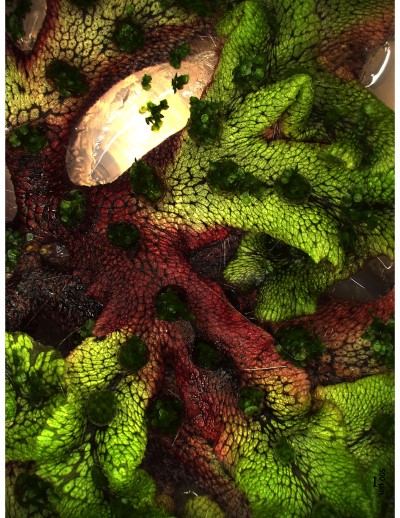Research
Published 17 September 2019Pigment discovery sheds new light on the environmental tolerance mechanisms of land plants

About 470-550 million years ago, ancient plant ancestors evolved the ability to grow on land, producing the first land plants.
Almost all plants studied previously have been found to contain red to blue coloured pigments called ‘anthocyanins’. Anthocyanins provide colours to flowers and fruit but also protect plants against environmental challenges. Until now scientists thought that anthocyanins evolved as plants left aquatic environments, and that these pigments would be common to all plant groups.
Marsden Funded research led by Dr Kevin Davies (Plant & Food Research), in collaboration with Lincoln University and scientists overseas, have made the ground breaking discovery of a new class of red pigment known as ‘auronidins’ in the closest living relatives to the first land plants, liverworts. This research has just been published in the high impact scientific journal Proceedings of the National Academy of Sciences of the USA (PNAS).
Understanding how plants evolved to become land-based may give us insights into how plants adapt and respond to shifts in environmental conditions and how they will respond to future climate changes,” says Dr Kevin Davies.
The discovery that there are no anthocyanins in liverworts, but rather auronidins, suggests that anthocyanins did not evolve in plants as early as commonly thought but arose much later, sometime after the last common ancestor of liverworts and seed plants. This discovery effectively rewrites our understanding of the role of pigments in early plant evolution.
Liverworts have a remarkable ability to survive in extreme environments. Newly discovered auronidin pigments may play a role in helping liverworts cope with land-based stresses such as UV-B light, drought or nutrient deprivation. Insights from further research on auronidins may inform crop breeding and growing practices. This ongoing Marsden Fund research will explore the function of auronidin pigments in more detail.
This raises questions about how the physiological role of red pigments has changed during plant evolution.” says Dr Kevin Davies.

Figure 2: A demonstration of auronidin fluorescence in the laboratory
The newly-discovered auronidin pigments contain novel colour properties, not found in anthocyanins. They are fluorescent and range in colour from yellow/orange to purple, and may have future technological applications for chemosensors, dye sensitized solar cells and pigments for food and cosmetics.
Journal Reference:
Berland H, Albert N, Stavland A, Jordheim M, McGhie T, Zhou Y, Zhang H, Deroles S, Schwinn K, Jordan B, Davies K, Andersen Ø 2019. Auronidins are a previously unreported class of flavonoid pigments that challenges when anthocyanin biosynthesis evolved in plants. Proceedings of the National Academy of Sciences of the United States of America
RESEARCHER
Dr Kevin Davis
ORGANISATION
Plant and Food Research
FUNDING SUPPORT
Marsden Fund
CONTRACT OR PROJECT ID
PAF1701
